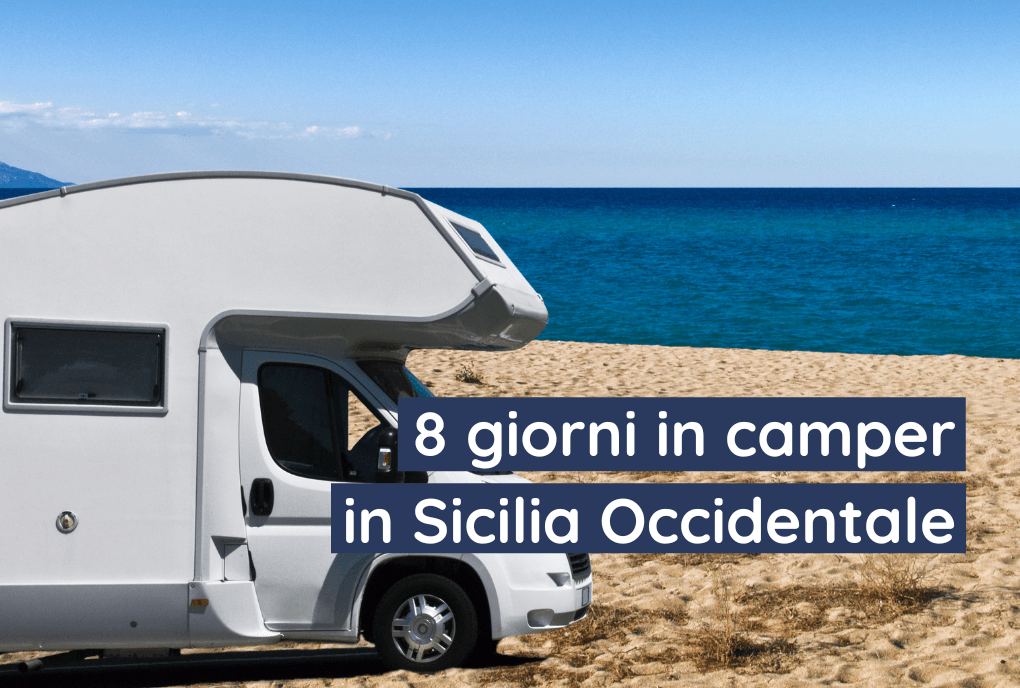
8 days in a motorhome in Western Sicily
Our magical journey through Sicily continues. In this itinerary we will discover Western Sicily capable of leaving anyone speechless with the beauty of its panoramas, natural and artistic wonders.
But let’s waste no more time and get aboard our four-wheeled house!
8-day RV itinerary in western Sicily
Stage 1 – Scopello
La our first stop is Scopello where his Tonnara, an open-air museum, a testament to the great tradition of tuna fishing in Sicily, awaits us. An expertly restored structure in an exceptional natural setting, surrounded by towering stacks. Visits are by appointment only.
Where to stay
A few meters before the walking entrance to the Tonnara there is a convenient parking lot for RVs as well.
Second stop – Mangiapane Cave in Custonaci
This place is truly unique: a huge cave carved between two mountains near the town of Custonaci
, in the province of Trapani. Inhabited since Paleolithic times, then by the Mangiapane family until after World War II. We recommend visiting the open-air museum, with living spaces and craft workshops, especially to families with children: they will be won over by such an incredible place. Admission is free.
Where to stay
There is ample free parking next to the site; for large RVs, the dirt road to get there is narrow and two-way, so great care must be taken.
Third Stage – San Vito lo Capo
The charming seaside village where we recommend you try the excellent cous cous, a dish so typical of the area that in September it hosts the Cous Cous Fest, a gastronomic event dedicated to this dish.
Where to stay
We recommend that you stay at the El-Bahira campground, which is very nice and equipped with a swimming pool, restaurant, all imaginable facilities, and also a fantastic sunset over the sea.
Fourth Stage -Trapani
A shining city to visit on foot and around the walls. Starting at the fish market square, continue for a walk along one of the most beautiful balconies overlooking the sea you can see, with pastel-colored cottages on one side and the beach on the other, until you reach the old rampart and continue to the Ligny Tower.
Trapani is blue and sand-colored gates, cloths laid out in the sun, churches and squares, and a beautiful corso to walk along.
Where to stay
You can park in the large parking lot in Vittorio Emanuele Square; not far away is a beautiful park, Villa Regina Margherita, surrounded by nature with games for children.
Fifth stage – Erice
A short distance from Trapani, we recommend that you make a stop in Erice. Leave the RV in the parking lot and take the cable car up. In 20 minutes you arrive in a world suspended in time. Streets paved with ups and downs between churches, squares and courtyards with countless souvenir and pottery stores, local products and restaurants with panoramic terraces.
The village is a little gem, definitely worth visiting. The cathedral located in the Matrice Square appears to be crocheted and next to it the Bell Tower. If you have time and calves, we recommend a slow visit, because Erice despite being a cosy village has so many attractions.
Sixth Stage – Marsala
There is only one narrow road that runs along the Salt Flats, where the various piers and places to have a drink meet. Lots of people head to the venue adjacent to the Hector and Infersa Salt Flats. This complex is certainly the most scenic, with the large, well-restored mill that can be visited and experienced, through different experiences.
Unique in its wonder and intensity is the sunset, which we recommend you see directly on the Island of Mozia, which can be reached by small boats, or on Isola Grande, which can be reached by crossing a small strip of land submerged by water, of varying heights.
Doves pause
Villa Genna picnic area
Seventh stage – Burri’s Cretto
Those who love and know art history will enjoy this detour to Alberto Burri’s symbolic Cretto: an example of land art located where the village of Gibellina Vecchia once stood.
The History of Gibellina is that of a town completely destroyed by an earthquake in 1968 with 1150 dead and many displaced. New Gibellina was rebuilt not far away, hosting several artists who contributed their works to its renovation.
Instead, Burri decided that he wanted to create something on the rubble of Gibellina Vecchia, as a testimony to what had happened. After reinforcing the rubble, he therefore created a concrete pour, using the technique of cracking that resembles clay carvings.
Burri kept the same street division, like wounds in the stone of the village as it was before the earthquake.
The effect is blinding white around the fields and green countryside, a maze of streets or a shroud, as they called it. The work has been much criticized we do not enter into controversy but we recommend if you have it to use a drone to get an overall view from above.
Eighth stage-Mazara del Vallo
We recommend parking on the seafront and exploring the Kasbah, the most multicultural area and the true historic center of Mazara. The narrow streets echo the Arab urban layouts typical of medinas. The narrow streets are narrow and it really feels like a North African town.
In fact, the most recent Tunisian immigration to Mazara began in the 1970s, making this city a true cultural melting pot. Mazara’s history has been accompanied by Arab culture for centuries, despite the arrival and evidence of Norman rule. Mosques are located near churches, and there are numerous cultural and community centers.
Mazara is dotted with ceramics, majolica, Moor heads and large vases, in a riot of colors but also thoughts and phrases to ponder. In fact, deep work on cultural integration and valuing differences is evident. You will find the Alley of Thought Child, with phrases of the little protagonists but also the Alley of Tolerance and the Bath Square.
A visit is certainly worthwhile to the museum of the dancing satyr, the extraordinary bronze statue, an original product of Greek art from the classical or Hellenistic period that is housed in the museum of the same name.
Where to stay
Camping The Emir’s Garden. Located about 1 km from the town center, their services are countless: shuttles, brioche and slushies in the morning, advice and solutions for every need.
Paola Crippa





